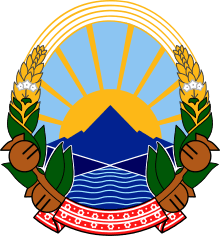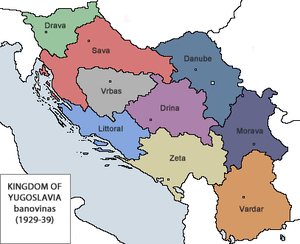Vardar Banovina
| Vardar Banovina Vardarska banovina Вардарска бановина | |||||
| Banovina of the Kingdom of Yugoslavia | |||||
| |||||
 Kingdom of Yugoslavia (light yellow) | |||||
| Capital | Skopje | ||||
| History | |||||
| - | Established | 3 October 1929 | |||
| - | Disestablished | 1941 | |||
| Area | |||||
| - | 1931 | 36,672 km2 (14,159 sq mi) | |||
| Population | |||||
| - | 1921 | 1,323,546 | |||
| - | 1931 | 1,574,243 | |||
| Density | 42.9 /km2 (111.2 /sq mi) | ||||
Part of a series on the |
|---|
| History of the Republic of Macedonia |
 |
| Chronological |
|
| Topical |
| Related |
| Republic of Macedonia portal |


The Vardar Banovina or Vardar Banate or Vardarska Banovina (Serbo-Croatian: Vardarska banovina, Вардарска бановина) was a province (banovina) of the Kingdom of Yugoslavia between 1929 and 1941. It was located in the southernmost part of the country, encompassing the whole of today's Republic of Macedonia, southern parts of Southern and Eastern Serbia and southeastern parts of Kosovo and Serbia. It was named after the Vardar River and its administrative capital was the city of Skopje.
According to the 1930 statistics of the Central Press Bureau of the Ministerial Council [1] out of the 9 Yugoslav banovinas, the “Vardarska” banovina was the largest at 38,879 km2 (15,011 sq mi); while its population, was the fourth at 1,386,370 inhabitants. It also suffered the worst health problems, especially typhus and smallpox, and required one Institute of Hygiene, 3 health stations and 6 dispensaries and convalescent homes. However, unlike the banovinas that until recently belonged to the Austro-Hungarian empire and the lands of Montenegro, it had inherited no debts.
Borders
According to the 1931 Constitution of the Kingdom of Yugoslavia,
- The Vardar Banovina is bounded on the north by the boundaries of the Zeta and Morava Banovinas, and on the east, south and west by the State frontiers with Bulgaria, Greece, and Albania.
History
In 1941, the World War II Axis Powers occupied the Vardar Banovina and divided it between Bulgaria, German-occupied Serbia, and Albania under Italy. Following World War II, the southern portion of the region became Socialist Republic of Macedonia while the northern portions were made a part of the Socialist Republic of Serbia, both within the Socialist Federal Republic of Yugoslavia.
See also
References
- ↑ published in the: Central Press Bureau of the Ministerial Council, Belgrade 1930
| ||||||||||||||||||||||
| Wikimedia Commons has media related to Vardar Banovina. |
Coordinates: 42°00′N 21°25′E / 42.000°N 21.417°E